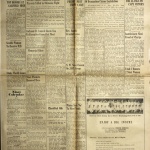Emergency Detention Act, Title II of the Internal Security Act of 1950
The Emergency Detention Act, Title II of the Internal Security Act of 1950, was Cold War era legislation that authorized the federal government to summarily detain any person suspected of espionage or sabotage or "whom there is reasonable ground to believe [will]... probably engage in... acts of espionage or sabotage" when the President declared an "internal security emergency." The law also authorized the Justice Department to construct detention facilities in preparation for such an emergency.
Dubbed the "concentration camp law," the legislation was strongly influenced by the World War II detention of Japanese Americans. A campaign to repeal the law twenty years later was an important precursor to what would become the redress movement .
Congress passed Title II in September 1950, in the context of the Cold War and anti-communist environment of that time. [1] The recent precedent of Japanese American removal and detention clearly influenced the legislation. Senator Paul H. Douglas of Illinois, one of the bill's sponsors, cited the Japanese American Supreme Court cases as having upheld the constitutionality of preventative detention of American citizens. [2] But Douglas and others saw problems with the mass race based detention of Japanese Americans and viewed the legislation as an improvement by instituting procedures for preventive detention and providing avenues for appeal to detainees.
In December 1952, attorney general J. Howard McGrath designated six potential camp sites under the provisions of Title II. One of them was the Tule Lake site that had been formerly used to detain Japanese Americans.
Ultimately, the law was never invoked and concentration camps were never activated. Despite opposition from civil liberties groups, the waning of anti-communist/Cold War hysteria, and being defunded in 1957, the law remained on the books for nearly twenty years until an ultimately successful effort to repeal it came into being in the late 1960s.
See also Repeal of Title II of the Internal Security Act of 1950.
For More Information
Austin, Allan Wesley. "Loyalty and Concentration Camps in America: The Japanese American Precedent and the Internal Security Act of 1950." In Last Witnesses: Reflections on the Wartime Internment of Japanese Americans . Edited by Erica Harth: 253–70. New York: Palgrave, 2001.
Izumi, Masumi. "Prohibiting 'American Concentration Camps': Repeal of the Emergency Detention Act and the Public Historical Memory of the Japanese American Internment." Pacific Historical Review 74.2 (May 2005): 165–93.
Okamura, Raymond Y. "Background and History of the Repeal Campaign." Amerasia Journal 2.2 (1974): 73-94.
Footnotes
- ↑ The legislation passed over the veto of President Harry S. Truman , who stated, "In a free country, we punish men for the crimes they commit, but never for the opinions they have." See Brian Masaru Hayashi, Democratizing the Enemy: The Japanese American Internment (Princeton: Princeton University Press, 2004), 212.
- ↑ Douglas (1892–1976), a liberal Democrat and University of Chicago economist, was regarded as a strong supporter of civil rights for African Americans. See his University of Chicago biography at http://www.lib.uchicago.edu/e/spcl/phdouglas.html .
Last updated July 15, 2020, 3:54 p.m..








